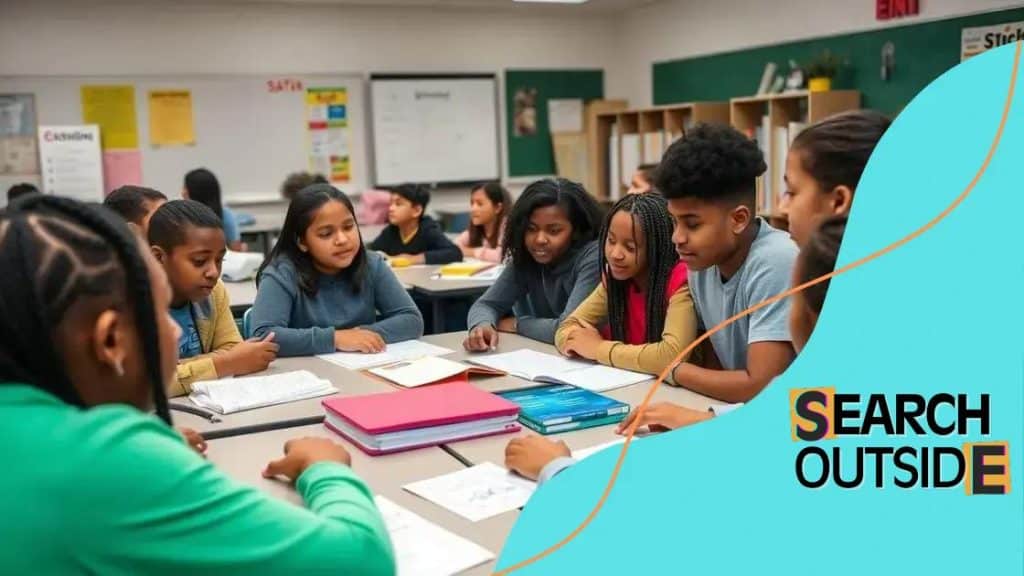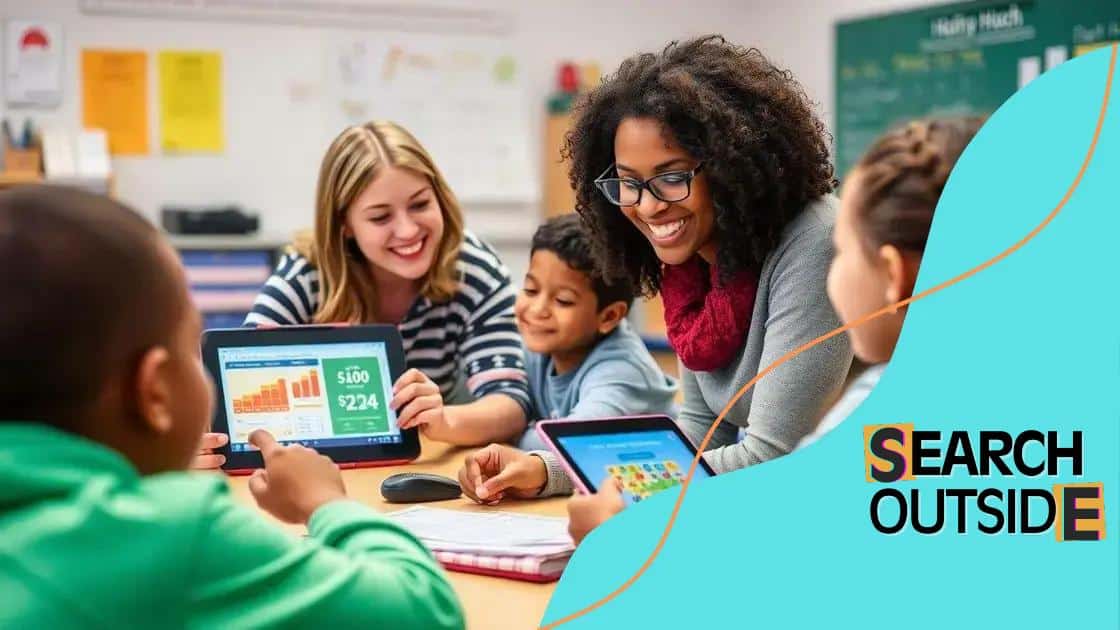How to incorporate financial literacy into high school education

Incorporating financial literacy into high school education equips students with essential skills to make informed financial decisions, enhancing their budget management and investment strategies for lifelong success.
How to incorporate financial literacy into high school education can empower students to make informed financial decisions in their future. Have you ever wondered how a strong foundation in finance can impact a young adult’s life? In this article, we’ll explore effective teaching methods that can make these concepts stick.
Understanding financial literacy and its importance
Understanding financial literacy is crucial for students as it lays the groundwork for their future financial decisions. With rising costs of living, knowledge in finance can make a significant difference in their lives. Students who grasp financial concepts are more likely to make informed decisions about savings, investments, and spending.
The Key Components of Financial Literacy
To improve financial literacy, educators should focus on key components that every student should learn. These components include:
- Budgeting and managing expenses
- Understanding credit and loans
- Saving and investing for the future
- Recognizing financial scams and risks
By incorporating these essential topics into lessons, students can build a strong foundation. For example, teaching how to create a budget can help students track their spending and identify areas for saving.
The Importance of Financial Decision-Making
Moreover, understanding financial literacy enhances critical decision-making skills. Students who are financially literate can evaluate their options better and understand the consequences of their choices. This approach not only prepares them for personal finance but also for larger economic systems they will encounter.
In addition, financial literacy can increase students’ self-confidence. When they learn to navigate their finances effectively, they are less likely to feel overwhelmed by financial obligations and more empowered to take charge of their financial futures. This confidence translates into smarter choices in higher education and beyond.
In conclusion, by implementing programs focused on understanding financial literacy, schools can equip students with the tools necessary for a secure financial future. The **importance** of these skills can’t be overstated, as they will play a vital role in students’ lives long after they leave school.
How financial literacy impacts student decision-making
How financial literacy impacts student decision-making is significant. When students are educated about personal finance, they can make better choices not just in school but in their everyday lives. Understanding basic finance concepts can drastically change their approach to spending, saving, and investing.
Improved Money Management Skills
With strong financial education, students learn money management skills that are crucial as they transition into adulthood. They are better equipped to handle expenses and budgeting, which can help alleviate stress related to financial issues. For instance, learning how to create a budget allows them to:
- Track their income and expenses effectively
- Identify areas of unnecessary spending
- Set financial goals for themselves
These skills are not merely academic; they have real-world applications that students will carry with them throughout their lives.
Informed Decision-Making
Additionally, financial literacy plays a crucial role in informed decision-making. Students who understand how credit works can make smarter choices about loans and credit cards. They learn the importance of maintaining a good credit score and how it affects their ability to make significant purchases in the future, like a car or a home.
The ability to compare financial products effectively helps students choose the options that are best for them. Having knowledge about interest rates, fees, and long-term costs enables them to weigh their options critically. These informed decisions can save them money and prevent them from falling into debt.
Furthermore, when students understand finances, they gain confidence in their ability to make choices. This confidence encourages them to take control of their financial futures, making them less prone to financial pitfalls.
Engaging methods for teaching financial concepts

Engaging methods for teaching financial concepts are essential in making learning fun and impactful. When educators use creative approaches, students are more likely to absorb and retain important information. Hands-on activities and interactive lessons can boost interest and participation.
Using Real-Life Scenarios
One effective way to teach financial literacy is through real-life scenarios. By using examples that students can relate to, like budgeting for a school event or planning a shopping trip, they can see the relevance of these concepts. Teachers might ask students to:
- Create a budget for a fictional school event
- Calculate the total cost of items on a shopping list
- Explore ways to save for a special purchase
This method encourages critical thinking and application of their knowledge in everyday situations.
Incorporating Technology in Learning
Another engaging approach involves incorporating technology into lessons. Online tools and apps can make learning about finance interactive and enjoyable. Students can use budgeting apps to track their personal finances or engage in financial simulation games. These tools can help them:
- Understand the value of money in real-time
- Experiment with virtual investments
- Compete with peers in financial literacy challenges
Through technology, students are not only learning but are also developing essential digital skills.
Furthermore, group projects can enhance collaboration and peer learning. When students work in teams to solve financial problems or present their findings, they benefit from different perspectives and insights. This collaborative effort often leads to deeper understanding and retention of financial concepts as they teach each other.
Incorporating real-life scenarios into lessons
Incorporating real-life scenarios into lessons is a powerful method to teach financial literacy effectively. When students can connect classroom concepts to their daily lives, they are more likely to understand and apply those concepts. Real-life examples help bridge the gap between theory and practice.
Relatable Situations
Teachers can use situations that students often face. For instance, discussing the costs associated with hosting a birthday party for a friend can illustrate budgeting and planning. Students can learn how to:
- Estimate expenses for food and entertainment
- Track their spending against a set budget
- Make choices based on their available resources
This strategy not only teaches financial concepts but also fosters decision-making skills.
Simulations of Financial Responsibility
Another effective technique is simulating financial responsibilities. By creating role-playing activities, students can experience managing money in various scenarios, such as:
- Applying for a student loan
- Investing in stocks or mutual funds
- Comparing prices and making purchases
Such simulations allow students to see the repercussions of their decisions, emphasizing the importance of making informed choices. Experiencing these scenarios firsthand makes the lessons memorable.
Furthermore, encouraging students to share their own financial experiences creates a collaborative learning environment. When students discuss their own spending habits or savings goals, they not only learn from the teacher but from each other. This exchange enriches their understanding and motivates them to engage more deeply with financial concepts.
Measuring the success of financial literacy programs
Measuring the success of financial literacy programs is crucial to understanding their effectiveness and impact on students. By evaluating these programs, schools can identify strengths, weaknesses, and areas for improvement. Effective measurement ensures that financial education meets students’ needs.
Key Metrics for Evaluation
One way to measure success is by setting clear and measurable goals. Schools can evaluate specific metrics such as:
- The increase in students’ financial knowledge and skills
- Improvements in students’ budgeting and saving habits
- The rate of student engagement during lessons
- Feedback from students and parents about the program’s relevance
By focusing on these metrics, educators can gauge the effectiveness of their teaching methods and the curriculum itself.
Surveys and Assessments
Regular surveys and assessments can provide valuable data. Pre- and post-program assessments help measure students’ knowledge before and after completing the course. Surveys can gather feedback on how students feel about managing their finances and what they learned by participating in the program.
Tracking changes in students’ behaviors—like increased saving or reduced spending—also offers insights into the program’s success. This data can help refine and adapt future financial literacy initiatives to better serve students’ needs.
Additionally, schools can analyze students’ performance in real-world financial scenarios. For instance, having students participate in a mock stock market or budgeting challenge can provide practical experience that shows how well they apply what they learned. Engaging students in these types of practical evaluations reinforces their learning.
FAQ – Frequently Asked Questions about Financial Literacy Programs
What is financial literacy?
Financial literacy is the ability to understand and use various financial skills effectively, including budgeting, saving, and investing.
Why is financial literacy important for students?
Financial literacy helps students make informed money decisions, empowering them to manage their finances and avoid debt.
How can real-life scenarios help in teaching financial concepts?
Real-life scenarios make lessons relatable and practical, allowing students to apply financial concepts to situations they encounter in daily life.
What methods can be used to evaluate the success of financial literacy programs?
Success can be measured through assessments, surveys, and tracking changes in student behaviors regarding budgeting and saving.





